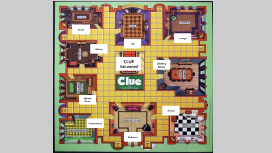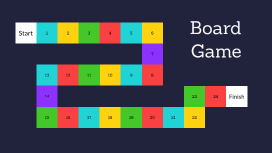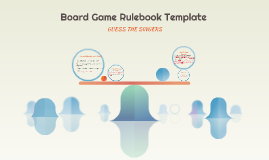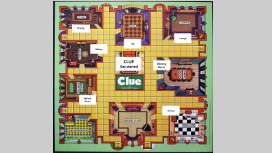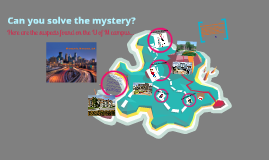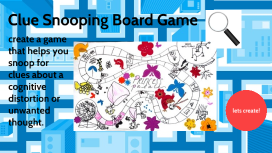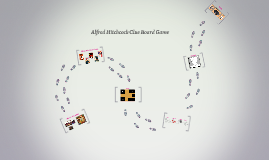Clue Game
Transcript: Study CLUE Get started Who made the correct diagnosis? It is your job to find the best DR and Diagnosis! Patricia Highsmith, a 21 year old English composition student, presents to the office with a 5 month history of amenorrhea. She is concern because her older sister has a similar problem and she has been unable to conceive despite trying for the past two years. She was fairly regular in her periods until age 17 when she started having scant periods and occasionally missing one altogether. In the past year, symptoms worsened until the previously mentioned moment when she had an episode of spotting for one day. This was her last period. The patient has also noted occasional episodes of excessive urination and thirst . She indicates a weight gain of 20 lbs in the past year. Hall Victim? Miss. Highsmith Physical Exam Physical Exam BP: 140/90 HR: 74 RR: 17 T: 36.8 C Weigh: 162 lbs Height: 5’3” BMI: 28.7 General: Alert, oriented x3 Skin: Facial acne. Hirsutism present HEENT: Extra ocular movements intact, pupils equally reactive to light and accommodation Lungs: Clear to auscultation Heart: Regular, no murmurs Abdomen: Soft and depressible, bowel sounds present No cyanosis or edema present Neuro: No focal deficits Labs Labs Clues Doctors Differential Diagnosis Dr. Andrés Dr. Ruth Dr. Natalia Dr. Jorge Dr. Alma Sertoli-Leydig Cell Tumor Polycystic Ovarian Syndrome Adrenal Tumor Congenital Adrenal Hyperplasia Cushing Disease Sertoli-Leydig Cell Tumor Billiard Room Dr. Alma Presentation Characteristic Features Gross Morphology Small, grey to yellow-brown mass Microscopy Well-differentiated tumors show tubules composed of Sertoli cells and Leydig cells interspersed in the stroma with Reinke crystals. Polycystic Ovarian Syndrome Dinning Room Dr. Natalia Pathophysiology Pathophysiology Presentation Clinical Presentation Diagnosis Diagnostic (Dx) methods Adrenal Tumor Kitchen Dr. Andrés Presentation Adrenal Neoplasia ADRENAL NEOPLASIA Pathophysiology Pathophysiology Clinical Features Clinical Features Diagnosis Diagnosis Congenital Adrenal Hyperplasia Lounge Dr. Ruth General Information Congenital Adrenal Hyperplasia 21- hydroxylase deficiency 21- hydroxylase deficiency 11-hydroxylase deficiency 11-hydroxylase deficiency 17-hydroxylase deficiency 17-hydroxylase deficiency Diagnosis Diagnosis Treatment Treatment Cushing's Disease Library Dr. Jorge Cushing's Disease Cushing's Disease Cushing's Syndrome CUSHING’S SYNDROME EXCESS CORTISOL EFFECTS EXCESS CORTISOL EFFECTS SKIN CHANGES SKIN CHANGES DIAGNOSIS DIAGNOSIS Study What do you think is the diagnosis? answer the poll on the chat Ballroom Polycystic Ovarian syndrome Epidemiology Epidemiology Inconsistency in Epidemiology Inconsistency in Epidemiology Presentation Clinical Features Polycystic Ovary Hyperandrogenism Ovulatory dysfunction oligomenorrhea amenorrhea ovary containing 12 or more follicles each measuring 2 to 9 mm an ovary >10 mL acne androgenic alopecia hirsutism High testosterone High DHEA Diagnosis Tests/Diagnosis Tests Tests/Diagnosis Treatment/Prevention Treatment / Prevention References Conservatory Group Members Alma González Andrés González Claudia Francia Iván Aponte Jorge Lázaro Natalia Cruz Nicole Estarellas Ruth Martell Capozzi, A., Scambia, G., & Lello, S. (2020). Polycystic ovary syndrome (PCOS) and adolescence: How can we manage it? European Journal of Obstetrics & Gynecology and Reproductive Biology, 250, 235-240. doi:10.1016/j.ejogrb.2020.04.024 Libè R, Fratticci A, Bertherat J. Adrenocortical cancer: pathophysiology and clinical management. Endocr Relat Cancer. 2007 Mar;14(1):13-28. doi: 10.1677/erc.1.01130. PMID: 17395972. Lonser RR, Nieman L, Oldfield EH. Cushing's disease: pathobiology, diagnosis, and management. J Neurosurg. 2017 Feb;126(2):404-417. doi: 10.3171/2016.1.JNS152119. Epub 2016 Apr 22. PMID: 27104844. MAPPING CONTROL géolocalisation de véhicules particuliers et entreprises. (n.d.). El síndrome de ovario poliquístico (SOP). Retrieved March 17, 2021, from https://www.galenusrevista.com/?El-sindrome-de-ovario-poliquistico. Rasquin Leon, L. I., & Mayrin, J. V. (2020). Polycystic Ovarian Disease. In StatPearls. StatPearls Publishing. Rocha AL, Oliveira FR, Azevedo RC, et al: Recent advances in the understanding and management of polycystic ovary syndrome. F1000Res 26;8, 2019. pii: F1000 Faculty Rev-565. doi: 10.12688/f1000research.15318.1. eCollection 2019. Stankiewicz, M., & Norman, R. (2006). Diagnosis and management of polycystic ovary syndrome: a practical guide. Drugs, 66(7), 903–912. https://doi.org/10.2165/00003495-200666070-00002 Williams, T., Mortada, R., & Porter, S. (2016, July 15). Diagnosis and treatment of polycystic ovary syndrome. Retrieved March 15, 2021, from https://www.aafp.org/afp/2016/0715/p106.html#:~:text=The%20clinical%20presentation%20of%20PCOS,oligomenorrhea%2C%20amenorrhea%2C%20or%20infertility






